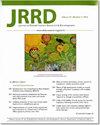Lower-limb amputation and effect of posttraumatic stress disorder on Department of Veterans Affairs outpatient cost trends.
Q Medicine
Journal of Rehabilitation Research and Development
Pub Date : 2015-07-01
DOI:10.1682/JRRD.2014.11.0288
引用次数: 20
Abstract
Department of Veterans Affairs (VA) outpatient costs were analyzed for combat Veterans injured in Iraq and Afghanistan from 2001 to 2008. Patients had serious lower-limb injuries (n = 170) or unilateral (n = 460) or bilateral (n = 153) lower-limb amputation(s). Total costs over the follow-up period (2003 to 2012) and annual costs were analyzed. Unadjusted mean costs per year in 2012 U.S. dollars were $7,200, $14,700 and $18,700 for limb injuries and unilateral and bilateral lower-limb amputation(s), respectively (p < 0.001). Multivariate modeling indicated that annual cost declined after the first year in the VA for Veterans with limb injuries (p < 0.001, repeated measures). In contrast, annual costs doubled after 3-5 years with unilateral (p < 0.001) and bilateral amputation(s) (p < 0.001). Among amputees, prosthetics comprised more than 50% of outpatient cost; unadjusted mean cost per year for prosthetics was 7-9 times higher in comparison with Veterans with limb injuries. Amputation status was associated with an adjusted 3.12-fold increase in mean prosthetic cost per year (p < 0.001, generalized linear model). In addition, posttraumatic stress disorder (PTSD) was associated with increased prosthetic cost by amputation status (p < 0.001) and increased psychiatric and pharmacy costs (both p < 0.001). Results indicate relatively high and sustained outpatient costs driven by prosthetics following amputation. Finally, PTSD affected cost for multiple domains of health, highlighting the importance of accurate diagnosis, treatment, and support for PTSD.下肢截肢及创伤后应激障碍对退伍军人事务部门诊费用趋势的影响。
对2001年至2008年在伊拉克和阿富汗受伤的退伍军人的门诊费用进行了分析。患者有严重下肢损伤(170例)或单侧(460例)或双侧(153例)下肢截肢。分析了随访期间(2003 - 2012年)的总成本和年度成本。2012年未经调整的平均成本分别为7200美元、14700美元和18700美元,分别用于肢体损伤和单侧和双侧下肢截肢(p < 0.001)。多变量模型显示,肢体损伤退伍军人在退伍军人事务部的第一年之后,年费用下降(p < 0.001,重复测量)。相比之下,单侧截肢(p < 0.001)和双侧截肢(p < 0.001) 3-5年后的年费用翻了一番。在截肢者中,义肢占门诊费用的50%以上;与肢体受伤的退伍军人相比,每年用于假肢的未经调整的平均费用高出7-9倍。截肢状况与每年平均假肢成本增加3.12倍相关(p < 0.001,广义线性模型)。此外,创伤后应激障碍(PTSD)与截肢状态增加的假肢成本(p < 0.001)以及增加的精神和药物成本(p < 0.001)相关。结果表明,截肢后修复术的门诊费用相对较高且持续。最后,创伤后应激障碍影响了多个健康领域的成本,强调了准确诊断、治疗和支持创伤后应激障碍的重要性。
本文章由计算机程序翻译,如有差异,请以英文原文为准。
求助全文
约1分钟内获得全文
求助全文

 求助内容:
求助内容: 应助结果提醒方式:
应助结果提醒方式:


